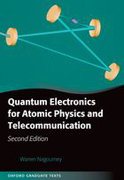
Complete coverage of basic quantum electronics Discussion of topics not usually covered in quantum electronics textbooks Class-tested, richly illustrated, wide range of problem sets at chapter ends Short course in frequency locking of lasers and general servomechanism theory Derivation of laser gain using both semiclassical quantum mechanical and phenomenological approach New to this edition Fiber optics: This reflects the increasingly widespread use of fiber optics devices in atomic physics and telecommunications Optical Bloch equations: This should help the reader to better appreciate the optical Bloch equation approach used in Chapter 5 Periodically-poled doubling in waveguides: A recent development which should greatly simplify devices based upon certain nonlinear processes, such as efficient second harmonic generation Comb generation using a microtorroid: Another recent development which should enormously simplify comb generation for frequency metrology Quantum Electronics for Atomic Physics provides a course in quantum electronics for researchers in atomic physics and other related areas such as telecommunications. The book covers the usual topics, such as Gaussian beams, lasers, nonlinear optics and modulation techniques, but also includes a number of areas not usually found in a textbook on quantum electronics. Among the latter are such practical matters as the enhancement of nonlinear processes in a build-up cavity or periodically polled waveguide, impedance matching into a cavity, laser frequency stabilization (including servomechanism theory), astigmatism in ring cavities, and frequency locking a laser to an atomic or molecular line. The second edition includes a new complete chapter on optical waveguide theory, fiber optic components and fiber lasers. Other updates include new coverage of mode locked fiber lasers, comb generation in a micro-resonator, and periodically poled optical waveguides. Readership: Graduate students and researchers in atomic physics; telecommunications workers; teachers of courses in quantum electronics in the physics, chemistry, or electrical engineering departments of a university or college.
- ISBN: 978-0-19-966548-8
- Editorial: OXFORD UNIVERSITY PRESS.
- Encuadernacion: Tela
- Páginas: 496
- Fecha Publicación: 08/05/2014
- Nº Volúmenes: 1
- Idioma:
